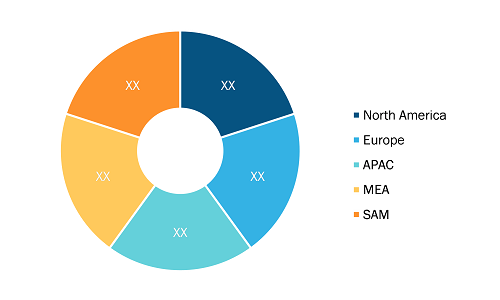The smart toilet market is expected to reach at US$ 11,620.76 million by 2028; registering at a CAGR of 11.4% from 2022 to 2028, according to a new research study conducted by The Insight Partners.
Rising need for conserving nonrenewable resources, increasing disposable income of individuals in developing countries, growing environmental concerns, surging technological developments, and government regulations for water saving are bolstering the acceptance of smart toilets in developing countries. In India, Orissa is witnessing contracts for smart toilet construction at a bus stand. In Delhi, GARV Toilets are the stainless steel portable smart public bio-toilets integrated with a RFID-IoT powered mobile app that shows data on people using the toilet, availability of water amount, and the frequency of toilet cleaning.
Smart Toilet Market Share – by Region, 2021
Smart Toilet Market Size and Forecast (2021 - 2031), Global and Regional Share, Trend, and Growth Opportunity Analysis Report Coverage: By Product Type (Wall Hung Toilet, Close-Coupled, Single Floor Standing Toilet, One-Piece Toilet, and Others), Connectivity Type (Wi-Fi & Integrated Control and Bluetooth & Remote Control), and End User (Residential and Commercial), and Geography
Smart Toilet market by Analysis by Size, Share Growth Report 2025
Download Free Sample
The rising adoption of smart cities is projected to boost the penetration of smart toilets in the coming period. The Government of India is investing US$ 7.3 billion in building 100 smart cities across India. The investment is predicted to improve sanitation facilities and make them smarter by installing restroom management solutions, smart toilets, and other technological products. Also, European researchers have been working on a Union-funded project known as iToilet. The project has commenced with testing amenities for disabled and elderly individuals. This project will include motorized toilets, which adjust their position based on voice commands, and depth sensors detecting in case a person has fallen. Once similar toilet will be commercialized, the developing nations of Europe will witness a boost in smart toilet market. Therefore, growing smart city initiatives and sanitation improvement projects in developing economies are expected to provide lucrative opportunities for the smart toilet market growth during the forecast period.
Impact of COVID-19 Pandemic on Smart Toilet Market
Water conservation is a major concern among the regulatory bodies across North America; they have also taken necessary measures by regulating certain standards related to the flush water volume for toilet system manufacturers. According to several sanitary associations, in the US, Canada, and Mexico, the flush water regulation accounts for ~6 liters or less water per flush, whereas in some parts of the US, the same regulation accounts for 4.8 liters or less water per flush. Also, the COVID-19 pandemic has led to an increase in water usage for sanitary and hygiene applications across the residential applications in the region, which has positively impacted the demand for smart toilets in North America. This has generated awareness for monitoring sanitary water usage among the end users; therefore, the demand for flush water usage monitoring is influencing the end users to adopt the smart toilet systems. This is contributing to the smart toilet market growth across North America in the post-pandemic recovery period.
The UK is a pioneer in adopting advanced technologies in Europe. The country has the highest adoption rate of smart and connected home solutions across the region. The high disposable income of the population and rising demand for technologically advanced products for increasing convenience are boosting the need for smart toilets across the country. The UK is also investing huge amount in developing advanced healthcare technology for continuous monitoring of health. Urine being one of the best sources to constantly monitor health of an individual; thus, the demand for smart toilets is expected to increase in the coming years for increasing health monitoring through collection and analysis of urine of individuals. Additionally, smart toilet market players such as Washloo in the country have also estimated that a household can save up to US$ 49.02 annually with the installation of smart toilets. These factors are expected to contribute to the growth of the smart toilet market in the UK during the forecast period.
The global smart toilet market share is segmented on the basis of product type, connectivity type, end user, and geography. Based on product type, the market is segmented into wall hung toilet, close-coupled, single floor standing toilet, one-piece toilet, and others. Based on connectivity type, the smart toilet market is bifurcated into Wi-Fi & integrated control and Bluetooth & remote control. Based on end user, the market is bifurcated into residential and commercial. The smart toilet market, based on region, is segmented into North America, Europe, Asia Pacific (APAC), the Middle East & Africa (MEA), and South America (SAM).
Lixil Corp, TOTO Ltd., Roca Sanitario SA, Kohler Co, and Duravit AG are a few key players operating in the smart toilet market. During this study, several major smart water market players were analyzed to get a holistic view of the global market and its ecosystem.
Contact Us
Phone: +1-646-491-9876
Email Id: sales@theinsightpartners.com